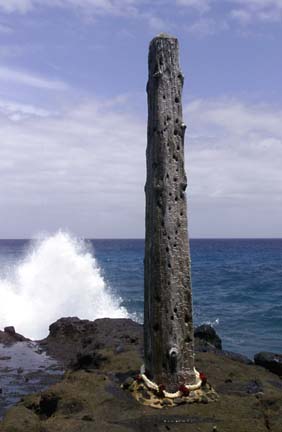

|
Kokua Line June Watanabe |
Wooden shore posts
serve as warnings
and memorialsQuestion: At Halona Blowhole, there is a post, probably concrete, like half a telephone pole, very near the actual blowhole. Can you find out the particulars about it -- when it was put there, by who and why?
Answer: We had the darnedest time trying to find information about the marker (actually made of wood), until John Clark, authority on and author of several books about Hawaii's beaches, came to our rescue. He also happens to be an assistant chief with the Honolulu Fire Department, as well as a member of the Hawaiian Historical Society who contributes a column (last Sunday of the month) on a "Hawaiian Moment" in the Star-Bulletin.
Clark mentions the post, which was erected as both a warning marker and a memorial, under the "Jizo" entry in his latest book, "Hawaii Place Names: Shores, Beaches, and Surf Sites."
FL MORRIS / FMORRIS@STARBULLETIN.COM
The post near Halona Blowhole was erected by a Japanese club in the 1930s as a warning to fishermen and memorial to those who drowned at the spot, according to local author John Clark. The marker originally had the Japanese character for "abunai," meaning "danger," painted on the side.
In fact, he's identified most of the shoreline memorials he's found throughout the islands in the book, which is set up as a glossary of 2,500 names, many of them accompanied by "mo'olelo," or stories, behind the names.
Although he mentions the Blowhole marker only in passing, Clark has compiled a fascinating history of such markers through interviews with fishermen and the families of the men who erected them along Oahu's coastline.
The marker at Blowhole "and many more were put up in the 1930s as a community service project by members of the former Honolulu Japanese Casting Club, the fishermen who pioneered ulua fishing at Bamboo Ridge next to the Blowhole," he told Kokua Line.
Club members mass-produced the markers and put them up on the rocky shores around Oahu, "pretty much where people fished or picked opihi," where someone had drowned.
The idea was to identify dangerous spots, as well as to erect a memorial for the victim, Clark said. Dozens of markers were set up before the project ended with the arrival of World War II.
The markers were made out of wood and had the Japanese character "abunai," meaning "danger," painted on the side, along with the English word "danger," he said.
After about 70 years of being exposed to the ocean elements, the Blowhole marker has no lettering on it and is weathered with holes and gashes.
In addition to that marker, only one other remains, Clark said, the rest being victims of high surf or vandalism.
The second marker is near Paioluolu, to the right of Hanauma Bay as you look out to sea, on the cliffs above an area that ulua fishermen call "Suicide Point," he said. The date "Nov. 25, 1934" is inscribed in its concrete base.
Clark says there apparently are other concrete bases left along the sea cliffs between Portlock Point and the Blowhole, although he's seen only one at First Bridge (also known as Ihiihilaukea Bridge) on the east side of the Lanai Lookout. The date on that concrete base is 1931, he said.
Horace Sasaki, son of one of the original members of the casting club's board of directors, remembers the markers when they were freshly cut, Clark said.
"He remembers his dad picking these up from wherever he got them from and storing them at his house," he said. "Then the club would go out and put them up every time someone was washed off a ledge and drowned."
At one time, several markers were erected near Blowhole, Clark said. One also was posted nearby at Bamboo Ridge, above Halona Cove, which is on the Hanauma Bay side of Blowhole.
On Bamboo Ridge, the casting club also erected a shrine to Jizo, a beloved Buddhist deity and guardian, in memory of Zensaku Uchibori, who died there while fishing, Clark said. Originally, the club imported a statue of Jizo from Japan to place at the site.
With the outbreak of World War II and anti-Japanese sentiment, the statue was damaged, its head destroyed.
To replace the damaged statue, Sentaro Otsubo, one of the club's officers who happened to be a stonemason, carved an image of Jizo into a boulder, Clark said.
"They put the boulder back up there, figuring that that would never be vandalized, and it sits up there to this day," he said. It is on the original concrete foundation built for the statue, he said.
As an aside: Clark was able to trace the original statue to the grounds of the Palolo Kwannon Temple. After it was vandalized, Otsubo took it home and recast the head. Following his death, his family donated it to the temple, which held a dedication ceremony for the statue on Nov. 24, 1963, Clark said.
|
See the Columnists section for some past articles.
Got a question or complaint?
Call 529-4773, fax 529-4750, or write to Kokua Line,
Honolulu Star-Bulletin, 500 Ala Moana Blvd., No. 7-210,
Honolulu 96813. As many as possible will be answered.
E-mail to kokualine@starbulletin.com
